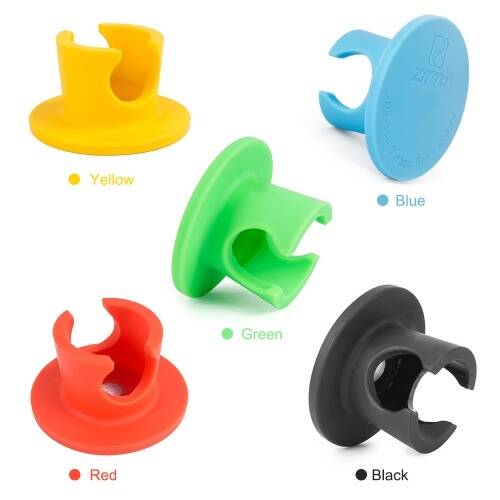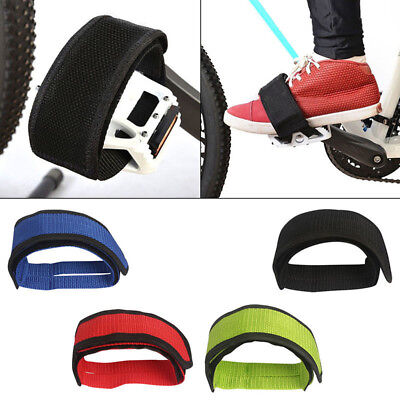
Types of Bicycle Anti-slip device
There are several types of bicycle anti-slip devices that cyclists can use to prevent slipping or sliding on the pedals. Here are a few examples:
- Clipless Pedals: A clipless pedal system is one of the most popular anti-slip devices for bicycles. It consists of special pedals that attach to cycling shoes with cleats. The cleats on the bottom of the shoes lock into the pedal, providing a firm and stable connection between the foot and the pedal.
- Toe Clips: Toe clips are straps that attach to the front of the pedals, holding the foot in place. Cyclists can tighten or loosen the straps to adjust the fit, and they can be used with any type of shoe.
- Anti-slip Wall Parking Rack:An anti-slip wall parking rack is a device that is used to store bicycles securely against a wall or other vertical surface. It is designed to hold the bike in place and prevent it from falling or slipping, even when bumped or jostled.
- Toe Cages: Toe cages are similar to toe clips but are made of metal or plastic and are designed to keep the foot in place with a cage instead of a strap. The cage is attached to the pedal and the cyclist’s foot slides in and out of the cage.
- Flat Pedals with Pins: Flat pedals with pins are designed to provide extra grip and prevent slipping. The pins are usually made of metal and stick out from the surface of the pedal, providing extra traction for the foot.
- Grip Tape: Grip tape can be applied to the surface of the pedals to provide extra grip and prevent slipping. The tape is usually made of a rough, textured material that provides traction for the foot.
Overall, the type of anti-slip device that a cyclist chooses will depend on their preferences, riding style, and the type of riding they plan to do.
Clipless Pedals:
Clipless pedals are a type of anti-slip device used on bicycles that consist of a special pedal and a matching cleat that attaches to the bottom of a cycling shoe. The pedal has a mechanism that allows the cleat to lock into it, creating a secure connection between the cyclist’s foot and the pedal. This system prevents the cyclist’s foot from slipping or sliding off the pedal, providing improved control and efficiency while riding.
Clipless pedals are particularly popular among road cyclists and mountain bikers, as they offer improved power transfer and efficiency compared to other types of pedals. They allow the rider to apply force to the pedals throughout the entire pedal stroke, rather than just during the downward stroke, which can increase power and speed.
One of the benefits of clipless pedals is that they can be adjusted to fit the rider’s preferences and riding style. The tension on the pedal can be adjusted to make it easier or harder to clip in and out, and the cleats can be positioned to provide different amounts of float or lateral movement.
However, clipless pedals can take some time to get used to, and they require specific cycling shoes with matching cleats. They can also be more expensive than other types of pedals, and some riders may prefer the simplicity and flexibility of other anti-slip devices, such as toe clips or flat pedals with pins.
Toe Clips:
Toe clips are a type of anti-slip device used on bicycles that consist of straps attached to the front of the pedals. The cyclist slips the front of their shoe into the strap, which holds their foot in place on the pedal. Toe clips are sometimes also called “toe cages” because they create a cage-like structure around the front of the cyclist’s foot.
Toe clips are a popular choice for many types of cyclists, including commuters, tourers, and road cyclists. They provide a secure connection between the cyclist and the pedal, which can increase pedaling efficiency and power transfer. They can also help prevent foot slippage on the pedal, which can be particularly useful in wet or slippery conditions.
One of the benefits of toe clips is that they can be used with any type of shoe, making them a versatile choice for cyclists who don’t want to invest in specific cycling shoes. They are also relatively inexpensive and easy to install on most types of pedals.
However, toe clips do have some limitations. They may not provide as much security or efficiency as clipless pedals, and they can be more difficult to get in and out of quickly. Some riders may also find that the straps are uncomfortable or restrict blood flow to the foot if they are too tight.
Overall, toe clips are a popular and effective anti-slip device for many types of cyclists, but they may not be the best choice for everyone. It’s important to consider your riding style, preferences, and goals when choosing an anti-slip device for your bike.

Anti-slip Wall Parking Rack
Anti-slip wall parking racks typically consist of a horizontal bar that is mounted to the wall, with one or more hooks or arms that extend out from the bar to hold the bike frame. The hooks or arms may be adjustable to accommodate different bike sizes and styles.
The anti-slip feature of these racks is usually achieved through the use of rubber or other materials that provide grip and traction. This helps to prevent the bike from slipping or sliding on the rack, which can prevent damage to the bike and ensure that it stays in place.
Anti-slip wall parking racks are a popular choice for bike storage in homes, apartments, and other indoor spaces where floor space is limited. They can also be used in outdoor settings, such as bike storage rooms or bike racks outside buildings.
Overall, an anti-slip wall parking rack is a simple and effective way to store your bike securely and protect it from damage. It can help you make the most of your available space while keeping your bike easily accessible and ready for your next ride.
Toe Cages:
Toe cages are a type of anti-slip device used on bicycles that are similar to toe clips but have a cage-like structure instead of a strap. The cage is attached to the front of the pedal and wraps around the front and sides of the cyclist’s foot, holding it in place on the pedal.
Toe cages are a popular choice for many types of cyclists, including commuters, tourers, and road cyclists. They provide a secure connection between the cyclist and the pedal, which can increase pedaling efficiency and power transfer. They can also help https://www.buydo.eu prevent foot slippage on the pedal, which can be particularly useful in wet or slippery conditions.
One of the benefits of toe cages is that they can be used with any type of shoe, making them a versatile choice for cyclists who don’t want to invest in specific cycling shoes. They are also relatively inexpensive and easy to install on most types of pedals.
However, toe cages may not provide as much security or efficiency as clipless pedals, which are another type of anti-slip device. Clipless pedals have a cleat that attaches to the bottom of a cycling shoe and locks into the pedal, providing a more secure and efficient connection between the cyclist and the pedal.
Overall, toe cages are a popular and effective anti-slip device for many types of cyclists, but they may not be the best choice for everyone. It’s important to consider your riding style, preferences, and goals when choosing an anti-slip device for your bike.
Flat Pedals with Pins:
Flat pedals with pins are a type of anti-slip device used on bicycles that consist of a flat platform with small pins or spikes on the surface. These pins provide extra grip and traction for the cyclist’s shoes, helping to prevent foot slippage on the pedal.
Flat pedals with pins are a popular choice for many types of cyclists, including mountain bikers, commuters, and BMX riders. They provide a wide platform for the foot, which can increase comfort and stability while riding. The pins also provide extra grip in wet or slippery conditions, which can be particularly important for mountain bikers or other off-road cyclists.
One of the benefits of flat pedals with pins is that they can be used with any type of shoe, making them a versatile choice for cyclists who don’t want to invest in specific cycling shoes. They are also relatively inexpensive and easy to install on most types of pedals.
However, flat pedals with pins may not provide as much security or efficiency as clipless pedals, which are another type of anti-slip device. Clipless pedals have a cleat that attaches to the bottom of a cycling shoe and locks into the pedal, providing a more secure and efficient connection between the cyclist and the pedal.
Overall, flat pedals with pins are a popular and effective anti-slip device for many types of cyclists, but they may not be the best choice for everyone. It’s important to consider your riding style, preferences, and goals when choosing an anti-slip device for your bike.
Grip Tape:
Gripping tape is a type of anti-slip device used on bicycles that consists of a strip of adhesive-backed tape with a textured surface. It can be applied to the surface of the pedal to provide extra grip and traction for the cyclist’s shoes, helping to prevent foot slippage on the pedal.
Gripping tape is a popular choice for many types of cyclists, including commuters, tourers, and BMX riders. It is relatively inexpensive and easy to apply, making it a simple and effective solution for improving the grip of pedals.
One of the benefits of gripping tape is that it can be used with any type of pedal and shoe, making it a versatile choice for cyclists who don’t want to invest in specific cycling shoes or pedals. It is also relatively durable and long-lasting, providing grip and traction for an extended period of time.
However, gripping tape may not provide as much security or efficiency as other types of anti-slip devices, such as clipless pedals or toe cages. These devices provide a more secure and efficient connection between the cyclist and the pedal, which can improve pedaling efficiency and power transfer.
Overall, gripping tape is a simple and effective anti-slip device for improving the grip of pedals. It is a popular choice for many types of cyclists, but may not be the best choice for everyone depending on their riding style and preferences.

0 Comments for “Bicycle anti-slip device”